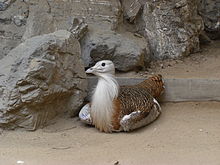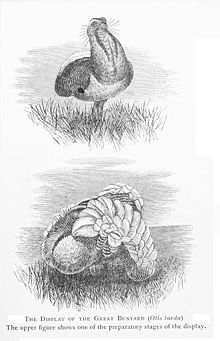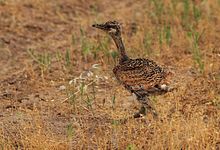- Great Bustard
-
Great Bustard 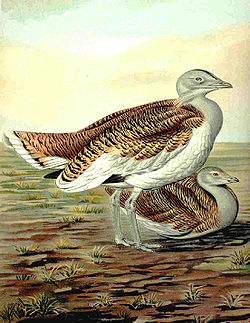
Conservation status Scientific classification Kingdom: Animalia Phylum: Chordata Class: Aves Order: Gruiformes Family: Otidae Genus: Otis
Linnaeus, 1758Species: O. tarda Binomial name Otis tarda
Linnaeus, 1758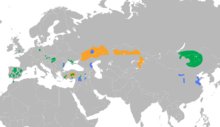
Mainly resident Mainly summering grounds Mainly wintering grounds
The Great Bustard, Otis tarda, is in the bustard family, the only member of the genus Otis. It breeds in southern and central Europe, where it is the largest species of bird, and across temperate Asia. European populations are mainly resident, but Asian birds move further south in winter.
Contents
Description
The male of this huge bird is possibly the heaviest living flying animal, alongside the similarly sized Kori Bustard. A male is typically 90–105 cm (35–41 in) tall, about 115 cm (45 in) long, has a 2.1–2.7 m (6.9–8.9 ft) wingspan and can weigh from 5.8 to 18 kg (13 to 40 lb), with an average of 13.5 kg (30 lb).[2][3][4] The heaviest verified specimen was about 21 kg (46 lb); larger specimens have been reported but remain unverified.[5][3] An adult male is brown above and white below, with a long grey neck and head. The breast and lower neck sides are chestnut. In the breeding season, the male has long white neck bristles. In flight, the long wings show large areas of white.
The female is about a third smaller in linear dimensions, typically measuring 75 to 85 cm (30 to 33 in) in height, about 90 cm (35 in) in length and 180 cm (5.9 ft) across the wings.[4][2] At an average of 4.4 kg (9.7 lb), the females are one-third the weight of the male. Overall, the female's weight can range from 3.3 to 8 kg (7.3 to 18 lb).[2][6][7] Perhaps because of this physical sexual dimorphism, there is a skewed sex ratio of about 1.5:1 female to male. The breast and neck of the female are buff. Both sexes are usually silent. Immature birds resemble the female.
Life history
Before mating, the males moult into their breeding plumage around January. Like other bustards, the male Great Bustard has a flamboyant display showing much white, mainly from the undertail, and withdrawing the head. The Great Bustard breeds in March, and a single male may mate with up to 5 females. All breeding Great Bustards also moult again from June to September.
Two or three olive or tan coloured, glossy eggs are laid in a small ground scrape. Eggs weigh about 150 g (5.3 oz) and are on average 79.4 mm (3.1 in) tall by 56.8 mm (2.2 in) wide. The female incubates the eggs alone for around 4 weeks. The chicks almost immediately leave the nest after they hatch, although they do not move very far from their mother until they are at least 1 year old. Young Great Bustards begin developing their adult plumage at about 2 months, and begin to develop flying skills at the same time. They practice by stretching, running, flapping, and making small hops and jumps to get airborne. By three months they are able to fly reasonable distances. Juveniles are independent by their first winter, but normally stay with their mother until the next breeding season. Males usually start to mate from about 5 years old. Great Bustards typically live for around 10 years, but some have been known to live up to 15 years or more. Adult males seem to have a higher mortality rate than females due mainly to fierce intraspecies fighting with other males during the breeding season.[8]
This bird's habitat is open grassland, although it can be found on undisturbed cultivation. It has a stately slow walk, and tends to run when disturbed rather than fly. It is gregarious, especially in winter. This species is omnivorous, taking seeds, insects and other small creatures, including frogs and beetles.
Over 80% of Great Bustards die in the first year of life. Chicks are endangered to predation by the fact that they are ground-dwelling birds who are reluctant to fly. Common predators of eggs and hatchlings include raptors, corvids, foxes, badgers and hedgehogs. Chicks grow very quickly, by 6 months nearly a two-thirds of their adult size, and are predated by foxes, lynx, wolves and eagles. The bold, conspicuous behavior of the breeding adult male bustard may attract large mammalian predators such as wolves and lynx, while the more inconspicuous female may sometimes be attacked by large eagles. However, predation is rare for adults due to their size, nimbleness and safety in numbers due to their social behavior.[9]
Two very rare albino Great Bustards from the same nest were killed by electricity cables in Hungary in 2000 and 2003[citation needed]. The bustards, despite their large size, are able to fly at a high velocity (60 kilometre/hour) and are often mutilated or killed by the cables which are placed in Hungary just at their flying heights. The electricity companies affected will bury only part of the dangerous cables, therefore the authorities are experimenting with fixing fluorescent "Firefly" devices on the most dangerous cables to provide the birds with warning lights.
The Great Bustard, túzok in Hungarian, is a national bird of Hungary and a subject of several proverbs.
Populations
The population numbers between 31,000 to 37,000 birds. Between 4,200 and 4,500 are found in east Asia. In recent times, there have been steep declines in population throughout eastern and central Europe and in Asia, particularly in Kazakhstan and Mongolia.
Range (2008) Presence Countries Native Afghanistan, Armenia, Austria, Azerbaijan, Bulgaria, China, Croatia, Czech Republic, France, Georgia, Germany, Greece, Hungary, Iran, Iraq, Italy, Kazakhstan, Kyrgyzstan, Macedonia, Moldova, Mongolia, Montenegro, Morocco, Portugal, Romania, Russia, Serbia, Slovakia, Spain, Syria, Tajikistan, Turkey, Turkmenistan, Ukraine, Uzbekistan Regionally extinct Algeria, Myanmar, Poland, Sweden, Switzerland, United Kingdom Vagrant Albania, Belgium, Cyprus, Denmark, Egypt, Finland, Gibraltar, Ireland, Israel, Japan, Korea, Latvia, Luxembourg, Malta, Netherlands, Saudi Arabia, Tunisia Presence uncertain Lebanon, Pakistan Sizeable populations exist in Spain (23,055 birds), Russia (8,000 birds), Turkey (800–3,000 birds), Portugal (1,435 birds) and Mongolia (1,000 birds). Elsewhere, the populations are declining due to habitat loss throughout its range. A sizeable population also exists in Hungary (1,100–1,300 birds) where the Eastern European steppe zone ends, near Dévaványa town and also in the Hortobágy, Nagykunság and Nagy-Sárrét regions. The population is down from a population of 10,000–12,000 before the Second World War. The Hungarian authorities are seeking to preserve the long-term future of the population by active protection measures: the area affected by the special ecological treatment had grown to 15 square kilometres by the summer of 2006.
The Great Bustard was formerly native in Great Britain and a bustard forms part of the design of the Wiltshire Coat of Arms. It was hunted out of existence by the 1840s. In 2004 a project overseeing the reintroduction to Salisbury Plain in Wiltshire using eggs taken from Saratov in Russia was undertaken by The Great Bustard Group, a UK Registered Charity that aims to establish a self-sustaining population of Great Bustards in the UK. They have laid eggs and raised chicks in Britain in 2009 and 2010.[10] Although the Great Bustard was once native to Britain, Great Bustards are considered an alien species under English law.[11][12] The reintroduction of the Great Bustard to the UK by the Great Bustard Group is being carried out in parallel with researchers from the University of Bath that are providing insight into the habitat of native Great Bustard populations in Russia and Hungary. On January 19 2011 it was announced that the Great Bustard Project had been awarded EU LIFE+ funding, reportedly to the tune of £1.8 million.[13]
References
- ^ BirdLife International (2004). Otis tarda. 2006. IUCN Red List of Threatened Species. IUCN 2006. www.iucnredlist.org. Retrieved on 11 May 2006. Database entry includes justification for why this species is vulnerable
- ^ a b c The UK Great Bustard reintroduction project
- ^ a b Wood, Gerald (1983). The Guinness Book of Animal Facts and Feats. ISBN 978-0-85112-235-9.
- ^ a b Payne-Galleway, Letters to Young Shooters on the Choice and Use of a Gun. General Books LLC (2009), ISBN 978-1150356452
- ^ http://scienceblogs.com/tetrapodzoology/2010/04/the_great_bustard_returns.php
- ^ Great Bustard Profile- Jrank (2011).
- ^ CRC Handbook of Avian Body Masses by John B. Dunning Jr. (Editor). CRC Press (1992), ISBN 978-0849342585.
- ^ http://greatbustard.org/about-the-birds/breeding
- ^ [1] (2011).
- ^ http://news.greatbustard.com
- ^ BBC News website, 2 June 2009
- ^ The Great Bustard Group
- ^ BBC News website
- Gorman, Gerard (1996). The Birds of Hungary. London: Helm (A&C Black). ISBN 0-7136-4235-1.
- Meissner, Hans Otto (1963). Unknown Europe. trans. Florence and Isabel McHugh. London and Glasgow: Blackie & Sons. pp. 125–139.
External links
Categories:- IUCN Red List vulnerable species
- Otididae
- Birds of Europe
- Birds of Asia
Wikimedia Foundation. 2010.


